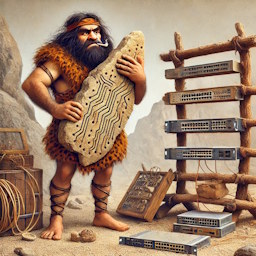Mastering the Network: Seeing the Full Picture in Troubleshooting
Posted on Tue 17 December 2024 in Networking
Introduction
In the world of network troubleshooting, perspectives can greatly influence outcomes—much like the well-known parable of the three blind men and the elephant. This story tells of three blind men who encounter an elephant for the first time, each touching a different part of the animal. One feels the trunk and declares the elephant is like a snake; another touches a leg and says it's like a tree; the third feels the side and insists it's like a wall. Each man, limited by his direct experience, believes he understands the whole elephant. Yet, none of them has the complete picture.

The Role of Bias in Network Troubleshooting
In troubleshooting, just as in the parable, personal experience and inherent biases can cloud our judgment. Confirmation bias leads us to favor solutions that align with our past experiences, potentially overlooking novel fixes or underestimating emerging issues. Limited perspective —our personal 'touch' of the elephant—can prevent us from seeing the full scope of a network problem, especially in complex environments. Emotional investment in our networks and our solutions can make it difficult to accept that a cherished methodology might be outdated or ineffective. Lastly, cognitive dissonance arises when new information conflicts with our established beliefs, causing discomfort and, sometimes, denial.
Recognizing these biases is the first step towards overcoming them. Like the blind men with the elephant, we must acknowledge that our perspective is just one part of a larger whole. We need to collaborate, share knowledge, and be open to the idea that our initial assessment may need adjustment.
Systematic Troubleshooting Steps
To ensure a comprehensive approach to network troubleshooting, following a structured methodology can help minimize the impact of personal bias:
- Identify the Problem: Clearly define the issue based on user reports and your own observations.
- Establish a Theory of Probable Cause: Consider all potential causes based on the symptoms, not just those you have encountered before.
- Test the Theory: This step verifies your hypothesis and ensures that the theory aligns with the reality of the problem.
- Plan and Implement a Solution: Develop a solution strategy that is both efficient and minimally disruptive.
- Verify System Functionality: After applying the fix, confirm that the system operates as expected without introducing new issues.
- Document: Keep detailed records of the problem and solution for future reference and learning.
- Feedback: Communicate with all stakeholders to confirm the resolution and gather feedback for future improvements.
Divide and Conquer Technique
One effective strategy in troubleshooting is the "divide and conquer" technique. This approach involves breaking down a large problem into smaller, more manageable parts to isolate the source of the issue. By methodically eliminating segments of the network that are functioning properly, you can focus your efforts on the areas that are likely causing trouble. This technique not only simplifies complex problems but also helps in pinpointing exact issues, facilitating a quicker resolution.
To further enhance the divide and conquer approach, the OSI Model or DoD Model can be invaluable tools. These models provide a layered framework that can help systematically isolate the problem area. You can leverage these models to methodically check each layer:
- Physical Layer: Verify all physical connections like cables and ports.
- Data Link Layer: Check MAC address filtering, Ethernet switches, and VLAN configurations.
- Network Layer: Ensure routing is intact and inspect IP configurations and subnet masks.
- Transport Layer: Look at TCP connections and port numbers.
- Application Layer: Check application-specific services that might impact connectivity.
For instance, if in an optimal environment you were able to ping a device but now cannot, start at the network layer and work down.
Conclusion
Mastering network troubleshooting requires more than technical skills—it demands an open mind and an awareness of our own biases. Like the blind men and the elephant, we must remember that our perspective is limited and collaboration is key. By employing structured troubleshooting methods and techniques like divide and conquer, and utilizing models like OSI or DoD for layered analysis, we can overcome biases to maintain and restore our networks more effectively.
